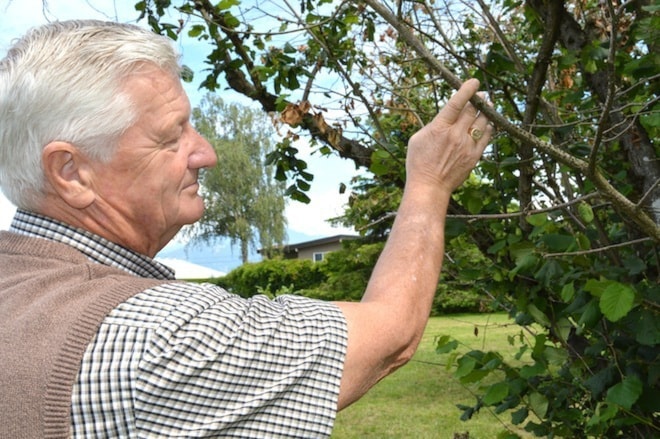It was a tough nut to crack.
Hazelnuts are once again growing in the 'Wack.
The emergence of a highly resistant type of tree to Eastern Filbert Blight has likely saved the industry locally, said Walter Esau, a Chilliwack hazelnut farmer and director with the B.C. Hazelnut Growers Association.
"It's revolutionized the whole industry in the Fraser Valley, and the future now looks quite bright," he said.
The Chilliwack Progress joined the hazelnut farmer recently for a stroll through his orchards, which has been replanted with the new variety of hazelnuts.
The young trees of varying heights appeared robust and blight-free.
The alarm first sounded in 2006 for the more than 50 Fraser Valley growers who were producing hazelnuts, also known as filberts.
There used to be about 1200 acres of hazelnuts in production province-wide.
"This was all mature orchard back then, about 75 years old," he said gesturing across the Chilliwack property, just under 10 acres, which used to be owned by his in-laws.
Soon all the growers' trees were hit with the Eastern Filbert Blight. They had no idea what was in store.
"They were trying to stop the disease from coming north to Canada."
But the disease entered via Abbotsford.
The wind-borne blight spores had floated into B.C. from Oregon and went about taking down all hazelnut farms, slowly but surely, with the blackened disease.
"We didn't know what the impact would be at first. Eventually it got all the older varieties. Certain strains were more susceptible."
Every single tree in his orchard had to be removed. It took heavy equipment to rip them out, and the trees were piled near the barn. It had to be accomplished over years, in four stages. He had to get a grinder in and then burn the material.
There didn't look like there was much hope until a company in Langley called Nature Tech found a way to bring the new type of highly resistant plant into B.C. via tissue culture.
"That's how the industry was restarted in the Valley."
He was one of five growers that received grant money from Western Diversification in 2010, that allowed them to get restarted as part of a testing site.
 His first replants are bearing hazelnuts now.
His first replants are bearing hazelnuts now.
Replanting in stages took about five years, and this season he expects to harvest about 1000 lbs per acre.
Eventually he'll be getting up to three times that number.
Down from 1200 acres being farmed a decade ago, there are now about 200 acres of hazelnuts in production in B.C.
The market is changing quickly, too. Five years ago it was mainly a North American product for a North American market.
"In the last year, China has taken 90 per cent of Oregon's hazelnuts."
Oregon is the biggest producer in North America. The world's largest producers are in Turkey and Spain.
"The thing is hazelnuts can't just be grown anywhere," said Esau.
The Fraser Valley, which doesn't even produce one per cent of the world's hazelnuts, has pretty close to the ideal climate for growing hazelnuts, with its temperate winters, and long seasons, that allow a dormant period.
Replanting the hazelnuts trees took about five years, said Esau. It's been expensive, but worth it, he figures.
More are being planted every year with the new variety, and the field price of hazelnuts has risen dramatically, he noted.
The Canadian border is still closed to bringing in hazelnut tree nursery products of any kind. But the tissue cultures in nurseries means they don't have to cross the border with the tree products.
This year he expects to harvest about 1000 lbs per acre. Eventually he says he'll be harvesting up to three times that.
The border is still closed to bringing in hazelnut tree nursery products of any kind. But the tissue cultures are used to create product in nurseries, which means they don't have to cross the border.
It's been expensive to start over, but it's a "good industry" with a non-perishable product that can be shipped anywhere. Some of the former producers have replanted, others have not.
"We're getting new ones all the time," said Esau. "So it's very encouraging."
Anyone interested in getting more information about becoming a grower can contact the B.C. Hazelnut Growers Association.
